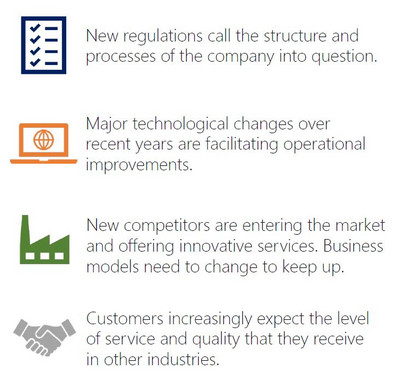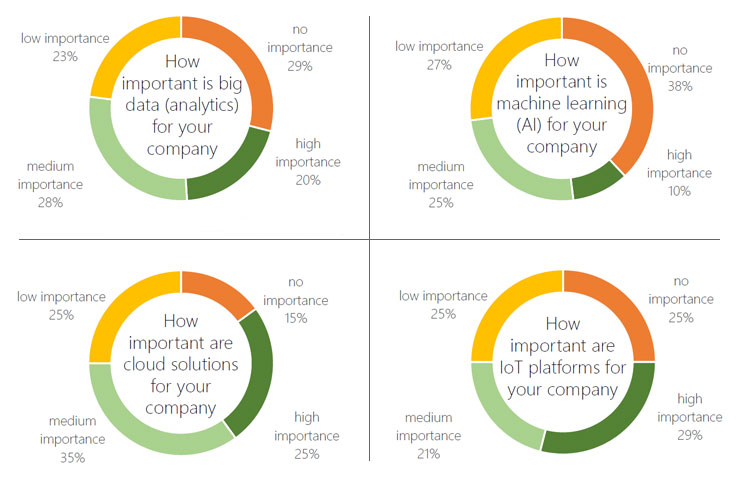Future-ready ERP systems - what to observe in project manufacturing

Why is ERP system modernization so important for project-based manufacturing in particular? One answer comes from a recently released long-term study by Trovarit: Two thirds of all those surveyed admitted that their business solution was no longer keeping up with current demands. The average age of the ERP systems looked at was 11.3 years. Nevertheless, more than 75% of those surveyed consider the ERP system to be the central data platform in their company.
New challenges in the digital age
In recent years, project manufacturers have focused primarily on optimizing products and product-related processes. In these areas, modern digital software technology is already being used to some degree. Examples include intelligent picking systems that pick goods from warehouses independently and transport them to the production workstation using optimized routes. Another area of application involves intelligent technologies used to determine servicing intervals based on factors like temperature and humidity.
“Now is the time to invest in digitalization and smart applications!”
The rest of the company, meanwhile, tends to lag behind. According to the VDMA IT-Report, 60% of all companies have not yet adopted an overall strategy for digitization. The Covid-19 pandemic, however, has brought about a huge increase in investments in digitalization activities. This trend has not yet caught on in all areas, though. Small and medium-sized companies in particular need to act fast, because the forces driving the digital transformation affect them the most:

Our free whitepaper "Future-proof ERP systems - What to consider" also provides you with interesting facts.
Keeping up with partners
A good example for this development is the issue of e-invoicing, which is on project managers’ agenda: Many businesses (above all, corporate suppliers) are being pushed to process invoices electronically.
Ensuring customer satisfaction
Customer service is also becoming more and more important, and software solutions for this sector are coming to the fore. Enterprise Content Management (ECM) systems, for example, simplify service work by automatically providing service staff with all the right documents – at the office or on the road. These new opportunities also increase service quality.
“We’re not there, yet”
Many of these topics are currently associated with cloud technology, which is still being met with hesitation. The general skepticism about cloud systems is abating. In many cases, however, the infrastructure has not caught up yet. What’s more, practical examples of application are still in short supply. The VDMA IT Report offers some insight into this question, too: The topic of artificial intelligence (AI) or machine learning, for example, is still rated as having little or no importance by a whopping 55% of businesses. The results paint a similar picture for cloud technology, big data and IoT.

Want to learn more about project planning? Check out our White Papers for more details.
So it looks like there’s still a lot of convincing to do. Most of all, system providers will need to demonstrate the advantages of holistic approaches and their superiority over conventional ERP systems.
Turning old into new
New technologies are not a “nice to have” – they’re a “must-have,” not least because business owners are feeling the pressure from partners and customers to switch to e-invoicing. Outdated systems obviously no longer meet current business standards either. Companies must modernize systems, harmonize the infrastructure and think about future cloud strategies in order to remain competitive. However, trying to do everything at the same time does not seem reasonable. Especially small-scale solutions can actually deliver massive benefits if they can be easily integrated into an overall concept.
Tip: How to Get Started
One good example is the use of artificial intelligence. Using small and lean solutions, you can already analyze product delivery periods in a variety of ways. Artificial intelligence detects deviations from the norm, factors in various influences and makes recommendations for optimum replenishment lead times. By periodically conducting these analyses, you can automatically increase data quality and delivery reliability.
Another possibility is expanding e-invoicing to other areas: The same technology can be used in procurement for order confirmations or in servicing for electronic work slips.
Incidentally, both of these examples are hybrid approaches. While they do both utilize the cloud, they do not require the ERP system itself to be run in the cloud. Modern ERP solutions, such as Microsoft Dynamics 365 products, can easily cope with these requirements. At the same time, you also get a wide enough range of functions to handle the special requirements of project-based manufacturing.
Summary
Manufacturing companies cannot afford to put off upgrading their IT systems. Customers and partners aren’t waiting around, and neither is the competition. There’s also no reason to keep cloud technologies off the table. Used in the right way, cloud services are an expedient way to add new functions to your system. There’s no need to put all your eggs in one basket. You can still run your company systems on-premises and simply add cloud functions on to them as needed. In any case, large, rigid and monolithic systems are on their way out. A modern business solution needs to be flexible, as well as open to new technologies, new concepts and new ideas.
Have you already heard of the COSMO CONSULT Digital Maturity Check? If you want to know where you currently stand in terms of digitalization and how you can get ahead quickly, you’ll find the right answer here!
